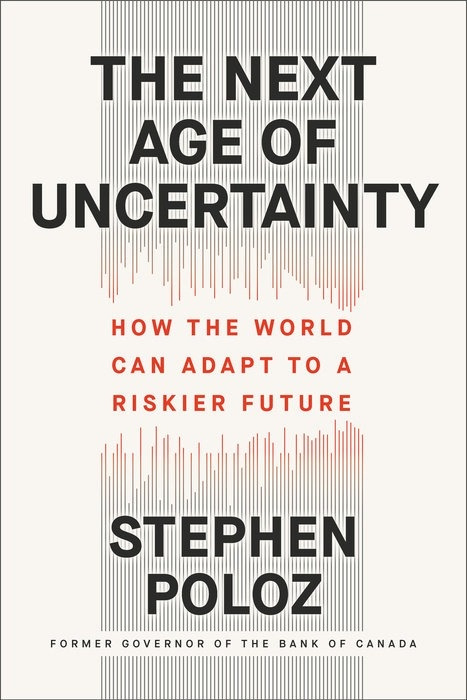Posted at 5:00 a.m.
The world of tomorrow, according to Stephen Poloz
There will be no shortage of risks facing households and businesses in the coming years, as indebted governments are weakened by the pandemic. Consequence: it will be necessary to prepare for hard knocks, because the State will not be able to come and save everyone.
This is the thesis proposed by former Governor of the Bank of Canada Stephen Poloz in his most recent book, The Next Age of Uncertainty – How the World Can Adapt to a Riskier Future, published by Penguin Random House. Rest assured, the book reads much better than a report on monetary policy!

PHOTO MARTIN TREMBLAY, PRESS ARCHIVES
The world of tomorrow, according to Stephen Poloz? The former Governor of the Bank of Canada invites households and businesses to prepare for inevitable economic shocks, without counting too much on the support of fiscal and monetary authorities to protect them from them.
The title echoes that of John Kenneth Galbraith’s book published in 1977, The Age of Uncertaintywritten in a period of turbulence to which we often compare ourselves these days.
The five tectonic plates that Mr. Poloz refers to are the aging of the population, technological progress, growing inequalities, indebtedness and climate change.
Of the five, only technological progress, propelled by applications of artificial intelligence, digitalization of the economy and advances in life sciences, has a positive effect on economic growth.
The world of tomorrow, according to Poloz? The interaction between these forces will inevitably cause shocks. It invites households and businesses to prepare accordingly, without relying too much on the support of fiscal and monetary authorities.
“The possibility that even a modest rise in interest rates could lead to a series of unusual business bankruptcies and job losses can seriously limit the ability of central banks to meet their inflation targets,” writes as an example the one who led the central bank of Canada from June 2013 to June 2020.
In this dangerous world, people should expect to lose their jobs more often, he warns.
Despite its good sides, technology will make jobs obsolete: driver, farm machinery operator, financial advisor, call center agent and store clerk. The author does not rule out a rise in the unionization rate as a result.
Housing under pressure
Mr. Poloz also expects sharp changes in interest rates. The speed of the current rate hike undertaken by the Bank of Canada seems to prove its former governor right.
This explosive mix of rising unemployment — a bold anticipation given the shrinking labor force — and sharp swings in interest rates will put housing under pressure.
“Expectations of a steady rise in real estate prices will be upset,” says the author. Periods of falling prices will be more noticeable and more memorable. There will be consequences for people’s attitudes towards housing,” he says in his chapter on the future of housing.
He advocates more innovations in the financing of houses. He calls in particular for a system of co-investment in houses between the borrower and the lender, a way of promoting home ownership for the youngest, according to him.
Despite its limited options due to its indebtedness, the state, according to Poloz, must adapt to the situation by offering automatic membership in social programs. He sees favorably the conversion of employment insurance into a guaranteed minimum income program, the rules of which will have to minimize its negative impact on the rate of participation in the labor market.
In passing, he applauds Quebec childcare centers for their benefits on the participation of women in the labor market.
Stephen Poloz intimate
Each of the 13 chapters begins with two or three pages of more personal content where we learn in small doses slices of the life of the great mandarin. Raised in a modest veterans’ home on Quebec Street in Oshawa, where three generations lived together, Mr. Poloz was not born with a golden spoon in his mouth. Having a father of Polish and Ukrainian origins, the renowned economist is an example of the “Canadian miracle”.
His efforts on the school benches were rewarded with diplomas from Queen’s and then Western, which opened the doors to federal institutions such as the Bank of Canada, Export Development Canada, then again the Bank of Canada, this time as signer of banknotes.
In this regard, he broke with tradition by signing the tickets with his full first name instead of just his initials. The reason ? Stephen is also his mother’s maiden name. By signing first and last name, the governor honored the memory of his parents in all discretion.
The author devotes a chapter to the hectic days he experienced in February and March 2020 when the spread of COVID-19 brought the economies of OECD member countries to a standstill and a coordinated response from central banks.
The book is not yet available in French.

The Next Age of Uncertainty – How the World Can Adapt to a Riskier Future
Stephen Poloz
Penguin Random House
Three quotes from the book
On climate change
“Around 80% of the world’s energy needs are met by fossil fuels today. It is simply not possible to suddenly stop producing and using fossil fuels, as some idealists advocate, without traumatic consequences for living standards. »
On the Bank of Canada’s quantitative easing during the pandemic
“It’s basically about creating money out of nothing. The underlying reason is that borrowers need more liquidity to be sure they can meet their day-to-day obligations without risking default. This is not at all the same as creating money out of thin air and forcing it into the economy, so that there is too much money for too few goods. When the demand for cash increases in times of stress, the risk is that there is too little money for too many goods. »
On the future of housing
“The net growth in house prices will continue even if the aging of the population means that it will be slower. Immigration is expected to increase. Inflation-adjusted interest rates are expected to remain very low for the foreseeable future, providing a solid foundation for housing as a whole. »

PHOTO HUGO-SEBASTIEN AUBERT, THE PRESS
Stephen Poloz, former Governor of the Bank of Canada, in November 2017
Questions to a renowned economist
In mid-July, The Press joined the special counsel at the law firm Osler, Hoskin & Harcourt, at his cottage on Lake Louisa, north of Lachute. Among the topics discussed – in French – with Stephen Poloz, there was question of household behavior, housing financing methods, price and wage control.
What can households do to deal with this more risky environment that you describe in your book?
For households, the change is to adopt a more prudent, more conservative financial plan, with leeway, because unemployment will be more frequent, probably shorter, but not necessarily. The turnover rate in the labor market will be higher.
The impact of unemployment on the household’s ability to pay mortgage debt is the most important factor of uncertainty. I think households are not going to buy the biggest house possible like in the past. They will have a higher safety cushion and level of savings to ensure greater financial flexibility.
Perhaps we will also see a higher rate of participation in the labor market than today, because it is another form of risk management of having two incomes in the same household, even if the one of them only works part-time.
According to your chapter on the future of housing, you seem to find merit in the extended mortgage amortization beyond 25 years. Why ?
Our attitudes towards debt have never really changed. By convention, the mortgage must be paid off in 25 years. This is the conventional plan. Today, mortgage lenders offer home equity lines of credit even to retirees. It’s seen as good financial flexibility. However, it is perfectly equivalent to a mortgage balance at retirement of a loan amortized over 50 years.
I don’t necessarily recommend taking a 50-year mortgage. What is needed is a more flexible financial system to manage a level of risk that will be higher in the future with, for example, co-investment models, which remain rare for the moment. Eventually, I think it will happen.
How would your co-investment model work?
When it comes time to buy a house, it’s expensive. First-time buyers can consider buying a half house (a semi-detached), it’s less expensive. With co-investment, you buy a house, but you only buy half of it with an investor [comme un prêteur hypothécaire], who will own the other half. It would have the merit of reducing the cost of living for everyone.
In your book, why are you concerned about the dispersal of the mandates of the monetary authorities?
Central bank mandates are correct mandates, but for the current inflationary situation, there are no good policies. It’s a matter of minimizing the problems and finding the trajectory that will bring us back to the 2% inflation target. In general, a central bank has only one tool, so there must be only one mandate. When we add objectives, it opens the door to debates and disagreements within the institution itself, in addition to providing an opportunity to politicize monetary policy.
What do you think of freezing prices and wages as a measure to fight inflation?
This is a difficult question. Currently, we are witnessing price changes in oil and raw materials that will affect the inflation rate temporarily. If you believe that the rise in the price of oil is temporary, it may make sense to consciously reverse this rise, and once the price of oil starts to fall, we could restore taxes, for example.
About two-thirds of the inflation we see comes from external sources such as rising commodity prices. It is a temporary rise in a price level, it is not permanent inflation. It looks like inflation for 12 to 18 months, but the price increases will reduce by themselves in the next six months by the base effect. The question for central banks is to manage the permanent part of inflation, the domestic part.
The preferred trajectory seems to be stagflation, ie an economic slowdown paired with high inflation, but one that is steadily declining. It is not possible to avoid stagflation, but we want it to last as short as possible. But we don’t know. It’s risky.

